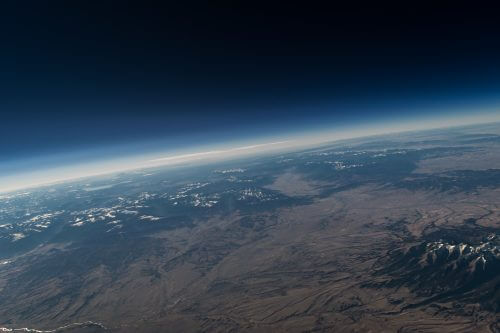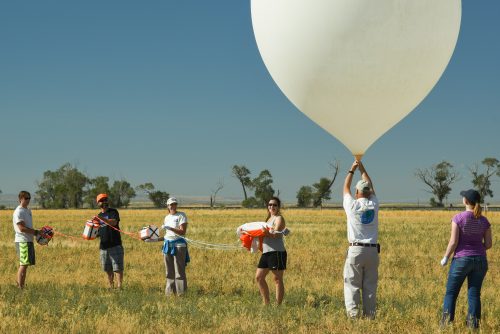NASA is partnering with student groups and students from all over the US to watch the eclipse from balloons.

The initiative NASA's Eclipse Balloon Project, led by Angela De Jardines from the University of Montana will launch over fifty balloons for groups of students to view the eclipse from an interesting angle of view - the edge of space. NASA will broadcast what these balloons will look like on its website: https://www.nasa.gov/eclipselive
Total solar eclipses are rare and an awe-inspiring phenomenon. No one had ever seen live aerial photography of a total solar eclipse before, de Jardines says. "Through the live broadcast on the Internet we provide people around the world with an opportunity to experience the eclipse in a unique way, even if they cannot watch it directly.
Research groups at NASA's Ames Center in California will take the opportunity of the balloon launch to conduct inexpensive experiments on 34 of the balloons. The experiment is called MicroStrat and its purpose is to test whether life can survive outside the Earth, and maybe even on Mars.
"The August eclipse will provide us with a rare opportunity to study the most Mars-like environment on Earth," says Jim Green, Director of the Planetary Sciences Division at NASA Headquarters. When the student teams will fly these facilities from dozens of points along the eclipse path, we will be able to study the effect on the microorganisms along the journey."
NASA will provide each group of students with two metal cards, the size of a dog name tag. Friendly bacteria will be found on the cards but resistant to the atmosphere when dried. One of the tickets will fly on the balloon while the other will stay on the ground. A comparison of the two will show the circumstances of the exposure to Martian-like cells such as the survival of the bacteria or any genetic changes.
The results of the experiments will improve NASA's understanding of the most extreme environment in which earthly life can exist in order to derive insights from it in the search for life on other worlds.
The density of the Martian atmosphere at ground level is only a percent of that of Earth, the temperatures are cooler and the radiation is stronger. The upper part of our stratosphere resembles these Martian conditions, with the cold, thin, radiation-exposed atmosphere due to its location above most of Earth's protective ozone layer. The temperatures at the altitudes where the balloons will fly can reach minus 35 degrees Celsius or less, with pressures about one hundredth of those at sea level.

During the eclipse the similarities to Mars will increase. The moon will block the radiation and heat from the sun. The eclipse will also reduce the ultraviolet radiation that is less abundant on Mars as well and its absence could lower the temperature even more.
"Performing a coordinated microbiology experiment across the entire United States in a balloon seems impossible under normal circumstances," said David G. Smith of Ames, the trial's principal investigator and director of the life sciences program. "The solar eclipse on August 21 provides an opportunity for unprecedented investigation by scientists and citizens. As a result of this experiment, we will have 10 times more samples to analyze than all past microbiology missions in the stratosphere combined.
The student teams will monitor the eclipse
Beyond the opportunity for NASA to perform scientific missions, this joint project provides an opportunity for young ten-year-old students to be exposed to the scientific method and astrobiology - the study of life beyond Earth. Because it is an inexpensive, low-cost technique, student teams from Puerto Rico to Alaska are participating in the project.
The data collected by the teams will be analyzed by NASA scientists in Ames and at NASA's Jet Propulsion Laboratory; medical researchers at Yale and Cornell; scientists funded by the National Science Foundation and the National Oceanographic and Atmospheric Administration; Faculty members and students at the institutions, as well as the public.
"This project not only provides insight into how life and microbes respond to Martian-like conditions, we are engaging and inspiring the next generation of scientists," Green said. "Through this exciting hitchhiking mission, NASA is collaborating with the scientists of the future and taking another small step in the search for life beyond our planet."
For information on the NASA website
More on the science website about the complete solar eclipse 2017:

6 תגובות
Why doesn't anyone say that the shadow cast on the earth goes from west to east and that doesn't make sense!!!
NASA says this is because the speed of the moon is twice the speed of the earth. But this is linear speed.
In three hours of the eclipse, the Earth moves angularly 45 degrees (3 hours divided by 24 hours multiplied by 360 degrees) and the Moon, on the other hand, moves angularly only 1.44 degrees (3 hours divided by 27 days (648 hours) of one revolution multiplied by 360 degrees).
Therefore the angular speed of the earth is 30 times faster and therefore the shadow should come from east to west! Like the directions between sunrise and sunset.
Why is it that none of the scientists in the world are talking about it?
I would love to get an answer to why the shadow moves from west to east.
giving
Israel
I laughed. The chance of cloudiness during the eclipse in the US is between 30 percent in the western US and about 40 percent in the east. In other words, there's a big chance for a rogue cloud to steal the two minutes of total eclipse for itself.
A pleasant eclipse!
As long as the story of the meteor shower from last Sunday is not repeated.. They said it starts at 11, at 10:30 we arrived the whole family with the cattle dog and the shepherd to the observatory with about 100 other people, excellent visibility. At 10:45 a terrible fog came down and covered the whole sky. thieves
https://www.youtube.com/watch?v=NJ_TC-IU5d4
Miracles
The story of the eclipse invitations in the USA is familiar to me as a member of the Israeli Astronomical Society. Indeed, he started more than a year ago, but…. "Previous important commitments" prevented me from making a reservation. I was more than ten years ago in an eclipse that was in Antalya and it was amazing. An experience that I wish for everyone and of course miracles for you too. Readers of the knowledge website will be happy to receive experiences and photos.
from the eclipse. I will watch the eclipse on the NASA website. So enjoy and I hope you chose an area with low cloud chances.
Good time
Sabdarmish Yehuda
Yehuda
Send you pictures? 🙂 I booked a year plus a hotel room in the area - and today they offer me 2000 dollars for the room 🙂
It is true that the eclipse is an opportunity for a party and a festive festival. And I envy all the members of the association who travel to the USA for the eclipse. But I think that NASA is exaggerating a bit. If they want to conclude from two minutes of a solar eclipse about life on Mars?, then conditions of darkness exist on Earth every evening/night, they last longer than two minutes, and you don't need a solar eclipse for that. Successfully!
Please respond gently.
Yehuda